Assessing Riverbank Change Caused by Sand Mining and Waste Disposal Using Web-Based Volunteered Geographic Information
Abstract
1. Introduction
2. Materials and Methods
2.1. Data Source and Study Areas
2.2. VGI System Components
2.3. System Implementation
2.4. Land Subsidence
2.5. Data Validation
- True Positive (TP): The number of instances of the phenomenon (sand mining or waste burial) being present both in the reference data (field studies) and the results of the study (information received from users). In other words, it represents the number of instances of the phenomenon successfully identified correctly as the target phenomenon (sand mining or waste burial).
- False Positive (FP): The number of instances of the phenomenon not existing in the reference data but being incorrectly identified as the target phenomenon in the study results.
- False Negative (FN): The number of instances of the phenomenon existing in the reference data but not being identified in the study results.
2.5.1. Completeness
2.5.2. Correctness
2.5.3. Quality
3. Results and Discussion
3.1. Explanation of System Details
3.2. Public Participation and Reporting
3.3. Regional Evaluation with Radar Interference Images
4. Conclusions
Author Contributions
Funding
Data Availability Statement
Conflicts of Interest
References
- Xiaohong, L.; Jie, C.; Hongyan, S. Cultural Connotation of Mountains, Rivers, Forests, Farmlands, Lakes, Grasslands and Deserts. J. Educ. Soc. Behav. Sci. 2023, 36, 104–115. [Google Scholar] [CrossRef]
- Horte, O.S.; Eisenman, T.S. Urban greenways: A systematic review and typology. Land 2020, 9, 40. [Google Scholar] [CrossRef]
- Sohns, A. River definitions reciprocally define us. Riv. Res. Appl. 2023; in press. [Google Scholar] [CrossRef]
- Fernandes, G.W.; Arantes-Garcia, L.; Barbosa, M.; Barbosa, N.P.; Batista, E.K.; Beiroz, W.; Resende, F.M.; Abrahão, A.; Almada, E.D.; Alves, E.; et al. Biodiversity and ecosystem services in the Campo Rupestre: A road map for the sustainability of the hottest Brazilian biodiversity hotspot. Perspect. Ecol. Conserv. 2020, 18, 213–222. [Google Scholar] [CrossRef]
- Miriti, M.N.; Rawson, A.J.; Mansfield, B. The history of natural history and race: Decolonizing human dimensions of ecology. Ecol. Appl. 2023, 33, e2748. [Google Scholar] [CrossRef] [PubMed]
- Karr, J.R.; Chu, E.W. Introduction: Sustaining living rivers. In Assessing the Ecological Integrity of Running Waters, Proceedings of the International Conference, Vienna, Austria, 9–11 November 1998; Springer: Dordrecht, The Netherlands, 2000; pp. 1–14. [Google Scholar]
- Postel, S.; Richter, B. Rivers for Life: Managing Water for People and Nature; Island Press: Lahaina, HI, USA, 2012. [Google Scholar]
- Rasul, G. Food, water, and energy security in South Asia: A nexus perspective from the Hindu Kush Himalayan region. Environ. Sci. Policy 2014, 39, 35–48. [Google Scholar] [CrossRef]
- Best, J. Anthropogenic stresses on the world’s big rivers. Nat. Geosci. 2019, 12, 7–21. [Google Scholar] [CrossRef]
- Anderson, E.P.; Jackson, S.; Tharme, R.E.; Douglas, M.; Flotemersch, J.E.; Zwarteveen, M.; Lokgariwar, C.; Montoya, M.; Wali, A.; Tipa, G.T.; et al. Understanding rivers and their social relations: A critical step to advance environmental water management. Wiley Interdiscip. Rev. Water 2019, 6, e1381. [Google Scholar] [CrossRef] [PubMed]
- Herman, F.; Beaud, F.; Champagnac, J.D.; Lemieux, J.M.; Sternai, P. Glacial hydrology and erosion patterns: A mechanism for carving glacial valleys. Earth Planet. Sci. Lett. 2011, 310, 498–508. [Google Scholar] [CrossRef]
- Gardner, J. How water, wind, waves and ice shape landscapes and landforms: Historical contributions to geomorphic science. Geomorphology 2020, 366, 106687. [Google Scholar] [CrossRef]
- Post, D.M.; Doyle, M.W.; Sabo, J.L.; Finlay, J.C. The problem of boundaries in defining ecosystems: A potential landmine for uniting geomorphology and ecology. Geomorphology 2007, 89, 111–126. [Google Scholar] [CrossRef]
- Morandín-Ahuerma, I.; Contreras-Hernández, A.; Ayala-Ortiz, D.A.; Pérez-Maqueo, O. Socio–ecosystemic sustainability. Sustainability 2019, 11, 3354. [Google Scholar] [CrossRef]
- Allan, J.D.; Castillo, M.M.; Capps, K.A.; Allan, J.D.; Castillo, M.M.; Capps, K.A. Rivers in the Anthropocene. In Stream Ecology: Structure and Function of Running Waters; Springer: Cham, Switzerland, 2021; pp. 1–17. [Google Scholar]
- Gladis, J.E. Conflict to Cooperation: An Axiological Analysis of Collaborative Resource Stewardship in the Nisqually River Watershed. Ph.D. Dissertation, University of Oregon, Eugene, OR, USA, 2023. [Google Scholar]
- Romagosa, F.; Eagles, P.F.; Lemieux, C.J. From the inside out to the outside in: Exploring the role of parks and protected areas as providers of human health and well-being. J. Outdoor Recreat. Tour. 2015, 10, 70–77. [Google Scholar] [CrossRef]
- Olivadese, M.; Dindo, M.L. Historic and Contemporary Gardens: A Humanistic Approach to Evaluate Their Role in Enhancing Cultural, Natural and Social Heritage. Land 2022, 11, 2214. [Google Scholar] [CrossRef]
- Sreebha, S.; Padmalal, D. Environmental impact assessment of sand mining from the small catchment rivers in the southwestern coast of India: A case study. Environ. Manag. 2011, 47, 130–140. [Google Scholar] [CrossRef]
- Koehnken, L.; Rintoul, M.S.; Goichot, M.; Tickner, D.; Loftus, A.C.; Acreman, M.C. Impacts of riverine sand mining on freshwater ecosystems: A review of the scientific evidence and guidance for future research. River Res. Appl. 2020, 36, 362–370. [Google Scholar] [CrossRef]
- Peduzzi, P. Sand, rarer than one thinks. Environ. Dev. 2014, 11, 682. [Google Scholar]
- Manju, U. I-sand: An environment friendly alternative to river sand in Reinforced Cement Concrete constructions. Constr. Build. Mater. 2016, 125, 1152–1157. [Google Scholar]
- Bhattacharya, R.K.; Chatterjee, N.D. River Sand Mining Modelling and Sustainable Practice; Springer International Publishing: Berlin/Heidelberg, Germany, 2021. [Google Scholar]
- Gavriletea, M.D. Environmental impacts of sand exploitation. Analysis of sand market. Sustainability 2017, 9, 1118. [Google Scholar] [CrossRef]
- Padmalal, D.; Maya, K.; Padmalal, D.; Maya, K. Impacts of river sand mining. In Sand Mining: Environmental Impacts and Selected Case Studies; Springer: Berlin/Heidelberg, Germany, 2014; pp. 31–56. [Google Scholar]
- Pandey, S.; Kumar, G.; Kumari, N.; Pandey, R. Assessment of causes and impacts of sand mining on river ecosystem. In Hydrogeochemistry of Aquatic Ecosystems; John Wiley & Sons Inc.: Hoboken, NJ, USA, 2023; pp. 357–379. [Google Scholar]
- Padmalal, D.; Maya, K.; Sreebha, S.; Sreeja, R. Environmental effects of river sand mining: A case from the river catchments of Vembanad lake, Southwest coast of India. Environ. Geol. 2008, 54, 879–889. [Google Scholar] [CrossRef]
- Ashraf, M.A.; Maah, M.J.; Yusoff, I.; Wajid, A.; Mahmood, K. Sand mining effects, causes and concerns: A case study from Bestari Jaya, Selangor, Peninsular Malaysia. Sci. Res. Essays 2011, 6, 1216–1231. [Google Scholar]
- Tobin, G.A. The levee love affair: A stormy relationship? JAWRA J. Am. Water Resour. Assoc. 1995, 31, 359–367. [Google Scholar] [CrossRef]
- Grundy-Warr, C.; Lin, S. The unseen transboundary commons that matter for Cambodia’s inland fisheries: Changing sediment flows in the Mekong hydrological flood pulse. Asia Pac. Viewp. 2020, 61, 249–265. [Google Scholar] [CrossRef]
- Gautam, D.; Adhikari, R.; Gautam, S.; Pandey, V.P.; Thapa, B.R.; Lamichhane, S.; Talchabhadel, R.; Thapa, S.; Niraula, S.; Aryal, K.R.; et al. Unzipping flood vulnerability and functionality loss: Tale of struggle for existence of riparian buildings. Nat. Hazards 2023, 119, 989–1009. [Google Scholar] [CrossRef]
- Madyise, T. Case Studies of Environmental Impacts of Sand Mining and Gravel Extraction for Urban Development in Gaborone. Ph.D. Dissertation, University of South Africa, Pretoria, South Africa, 2013. [Google Scholar]
- Jones, R.; Bessell-Browne, P.; Fisher, R.; Klonowski, W.; Slivkoff, M. Assessing the impacts of sediments from dredging on corals. Mar. Pollut. Bull. 2016, 102, 9–29. [Google Scholar] [CrossRef] [PubMed]
- Jan, F.; Min-Allah, N.; Düştegör, D. Iot based smart water quality monitoring: Recent techniques, trends and challenges for domestic applications. Water 2021, 13, 1729. [Google Scholar] [CrossRef]
- Mishra, R.K. Fresh water availability and its global challenge. Br. J. Multidiscip. Adv. Stud. 2023, 4, 1–78. [Google Scholar] [CrossRef]
- Yang, Y.; Zheng, J.; Zhang, M.; Zhu, L.; Zhu, Y.; Wang, J.; Zhao, W. Sandy riverbed shoal under anthropogenic activities: The sandy reach of the Yangtze River, China. J. Hydrol. 2021, 603, 126861. [Google Scholar] [CrossRef]
- Siddha, S.; Sahu, P. Impact of climate change on the river ecosystem. In Ecological Significance of River Ecosystems; Elsevier: Amsterdam, The Netherlands, 2022; pp. 79–104. [Google Scholar]
- Ayyam, V.; Palanivel, S.; Chandrakasan, S.; Ayyam, V.; Palanivel, S.; Chandrakasan, S. Sand mining and strategies for Its management. In Coastal Ecosystems of the Tropics-Adaptive Management; Springer: Singapore, 2019; pp. 201–217. [Google Scholar]
- Ta, W.; Jia, X.; Wang, H. Channel deposition induced by bank erosion in response to decreased flows in the sand-banked reach of the upstream Yellow River. Catena 2013, 105, 62–68. [Google Scholar] [CrossRef]
- Kondolf, G.M.; Schmitt, R.J.; Carling, P.; Darby, S.; Arias, M.; Bizzi, S.; Castelletti, A.; Cochrane, T.A.; Gibson, S.; Kummu, M.; et al. Changing sediment budget of the Mekong: Cumulative threats and management strategies for a large river basin. Sci. Total Environ. 2018, 625, 114–134. [Google Scholar] [CrossRef]
- Ekka, A.; Pande, S.; Jiang, Y.; der Zaag, P.V. Anthropogenic modifications and river ecosystem services: A landscape perspective. Water 2020, 12, 2706. [Google Scholar] [CrossRef]
- Da, S.; Le Billon, P. Sand mining: Stopping the grind of unregulated supply chains. Extr. Ind. Soc. 2022, 10, 101070. [Google Scholar] [CrossRef]
- Langer, W. Sustainability of aggregates in construction. In Sustainability of Construction Materials; Woodhead Publishing: Sawston, UK, 2016; pp. 181–207. [Google Scholar]
- Agboola, O.; Babatunde, D.E.; Fayomi, O.S.I.; Sadiku, E.R.; Popoola, P.; Moropeng, L.; Yahaya, A.; Mamudu, O.A. A review on the impact of mining operation: Monitoring, assessment and management. Results Eng. 2020, 8, 100181. [Google Scholar] [CrossRef]
- Venkateswarlu, K.; Nirola, R.; Kuppusamy, S.; Thavamani, P.; Naidu, R.; Megharaj, M. Abandoned metalliferous mines: Ecological impacts and potential approaches for reclamation. Rev. Environ. Sci. Bio/Technol. 2016, 15, 327–354. [Google Scholar] [CrossRef]
- Worlanyo, A.S.; Jiangfeng, L. Evaluating the environmental and economic impact of mining for post-mined land restoration and land-use: A review. J. Environ. Manag. 2021, 279, 111623. [Google Scholar] [CrossRef]
- Hackney, C.R.; Darby, S.E.; Parsons, D.R.; Leyland, J.; Best, J.L.; Aalto, R.; Nicholas, A.P.; Houseago, R.C. River bank instability from unsustainable sand mining in the lower Mekong River. Nat. Sustain. 2020, 3, 217–225. [Google Scholar] [CrossRef]
- Arthington, Á.H.; Naiman, R.J.; Mcclain, M.E.; Nilsson, C. Preserving the biodiversity and ecological services of rivers: New challenges and research opportunities. Freshw. Biol. 2010, 55, 1–16. [Google Scholar] [CrossRef]
- Capodaglio, A.G. Integrated, decentralized wastewater management for resource recovery in rural and peri-urban areas. Resources 2017, 6, 22. [Google Scholar] [CrossRef]
- Srinivas, R.; Singh, A.P.; Shankar, D. Understanding the threats and challenges concerning Ganges River basin for effective policy recommendations towards sustainable development. Environ. Dev. Sustain. 2020, 22, 3655–3690. [Google Scholar] [CrossRef]
- Elwood, S.; Goodchild, M.F.; Sui, D.Z. Researching volunteered geographic information: Spatial data, geographic research, and new social practice. Ann. Assoc. Am. Geogr. 2012, 102, 571–590. [Google Scholar] [CrossRef]
- See, L.; Mooney, P.; Foody, G.; Bastin, L.; Comber, A.; Estima, J.; Fritz, S.; Kerle, N.; Jiang, B.; Laakso, M.; et al. Crowd-sourcing, citizen science or volunteered geographic information? The current state of crowd-sourced geographic information. ISPRS Int. J. Geo-Inf. 2016, 5, 55. [Google Scholar] [CrossRef]
- Antoniou, V. On volunteered geographic information quality: A framework for sharing data quality information. In Geoinformatics for Geosciences; Elsevier: Amsterdam, The Netherlands, 2023; pp. 149–160. [Google Scholar]
- Vahidnia, M.H. Citizen participation through volunteered geographic information as equipment for a smart city to monitor urban decay. Environ. Monit. Assess. 2023, 195, 181. [Google Scholar] [CrossRef]
- Moghadas, M.; Rajabifard, A.; Fekete, A.; Kötter, T. A framework for scaling urban transformative resilience through utilizing volunteered geographic information. ISPRS Int. J. Geo-Inf. 2022, 11, 114. [Google Scholar] [CrossRef]
- Koswatte, S.; McDougall, K.; Liu, X. SDI and crowd-sourced spatial information management automation for disaster management. Surv. Rev. 2015, 47, 307–315. [Google Scholar] [CrossRef]
- Bao, J.; Zheng, Y.; Wilkie, D.; Mokbel, M. Recommendations in location-based social networks: A survey. GeoInformatica 2015, 19, 525–565. [Google Scholar] [CrossRef]
- Li, Z.; Huang, Q.; Emrich, C.T. (Eds.) Social Sensing and Big Data Computing for Disaster Management; Routledge: London, UK, 2020. [Google Scholar]
- Tiwari, P.C.; Pal, R.; Chaudhary, M.J.; Nath, R. Artificial intelligence revolutionizing drug development: Exploring opportunities and challenges. Drug Dev. Res. 2023, 84, 1652–1663. [Google Scholar] [CrossRef]
- Verplanke, J.; McCall, M.K.; Uberhuaga, C.; Rambaldi, G.; Haklay, M. A shared perspective for PGIS and VGI. Cartogr. J. 2016, 53, 308–317. [Google Scholar] [CrossRef]
- Boella, G.; Calafiore, A.; Grassi, E.; Rapp, A.; Sanasi, L.; Schifanella, C. FirstLife: Combining social networking and VGI to create an urban coordination and collaboration platform. IEEE Access 2019, 7, 63230–63246. [Google Scholar] [CrossRef]
- Abbasi, K.; Mouludi-Saleh, A.; Eagderi, S. The variability of morphometric and meristic characteristics of Urmia chub, Petroleuciscus ulanus (Günther, 1899) in the Mahabd-Chai and Godar-Chai rivers, Lake Urmia basin. Limnol. Freshw. Biol. 2021, 4, 1156–1159. [Google Scholar] [CrossRef]
- Houshyar, H. CDS Strategy-Based Participatory Vision Building in Border Cities (Case Study: Oshnavieh City). J. Bord. Sci. Technol. 2020, 9, 1–33. [Google Scholar]
- Mohammadpour, M. Water Use Management Effect on the Oshnavieh and Naghadeh Plain’s Surface-Water Resource Using WEAP Model. Water Resour. Eng. 2020, 13, 71–84. [Google Scholar]
- Geo Server. An Open Source Server for Sharing Geospatial Data. Available online: http://geoserver.org/ (accessed on 20 February 2024).
- Miu, M.; Zhang, X.; Dewan, M.A.A.; Wang, J. Development of Framework for Aggregation and Visualization of Three-Dimensional (3D) Spatial Data. Big Data Cogn. Comput. 2018, 2, 9. [Google Scholar] [CrossRef]
- Crosetto, M.; Monserrat, O.; Cuevas-González, M.; Devanthéry, N.; Crippa, B. Persistent scatterer interferometry: A review. ISPRS J. Photogramm. Remote Sens. 2016, 115, 78–89. [Google Scholar] [CrossRef]
- Cian, F.; Blasco, J.M.D.; Carrera, L. Sentinel-1 for monitoring land subsidence of coastal cities in Africa using PSInSAR: A methodology based on the integration of SNAP and staMPS. Geosciences 2019, 9, 124. [Google Scholar] [CrossRef]
- Serco Italia SPA. SNAP2StaMPS: Data Preparation for StaMPS PSI Processing with SNAP-Mexico City 2020 (Version 1.1). 2020. Available online: https://eo4society.esa.int/wp-content/uploads/2022/01/HAZA09_SNAP2StaMPS_MexicoCity_Tutorial.pdf (accessed on 20 February 2024).
- Delgado Blasco, J.M.; Foumelis, M.; Stewart, C.; Hooper, A. Measuring urban subsidence in the Rome metropolitan area (Italy) with Sentinel-1 SNAP-StaMPS persistent scatterer interferometry. Remote Sens. 2019, 11, 129. [Google Scholar] [CrossRef]
- Roostaei, S.; Najafvand, S. Plain Subsidence Monitoring based on SNAP2STAMPS Automated Algorithm by Radar Interferometry (PSI) Method (Case study: Marand Plain). J. Geogr. Environ. Hazards 2023, 11, 21–42. [Google Scholar]
- Duan, M.; Xu, B.; Li, Z.; Wu, W.; Cao, Y.; Liu, J.; Wang, G.; Hou, J. A new weighting method by considering the physical characteristics of atmospheric turbulence and decorrelation noise in SBAS-InSAR. Remote Sens. 2020, 12, 2557. [Google Scholar] [CrossRef]
- Maleki, M.; Sabour, S.M.T.; Rahmati, M.; Arjomand, B. Statistical integration of radar and optical data for geomorphological feature extraction. Int. J. Image Process. Pattern Recognit. 2017, 3, 1–10. [Google Scholar]
- Maleki, M.; Tavakkoli Sabour, S.M.; Zeaieanfirouzabadi, P.; Raeisi, M. Comparison of optic and radar data for terrain feature extraction. J. RS GIS Nat. Resour. 2018, 9, 93–107. [Google Scholar]
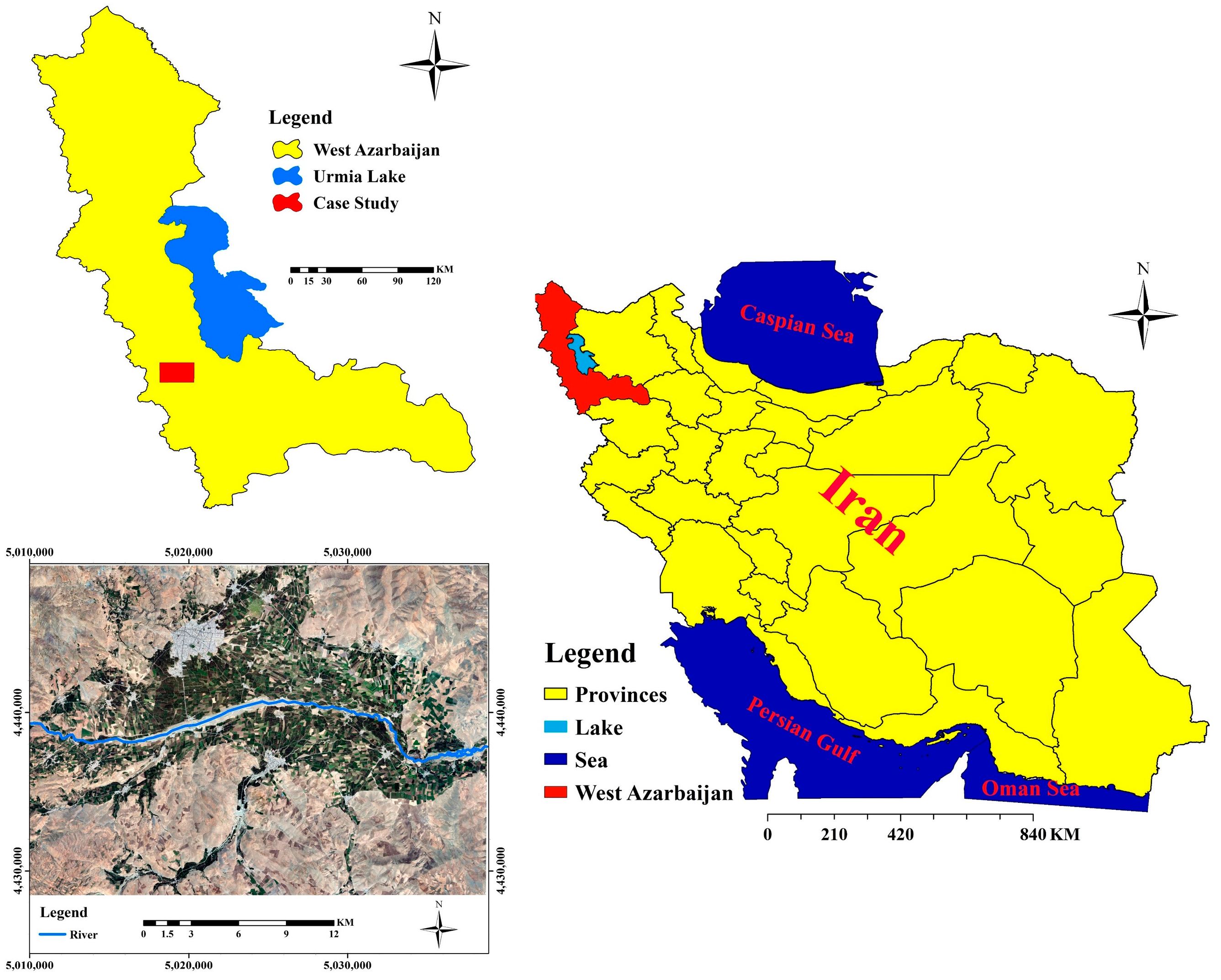
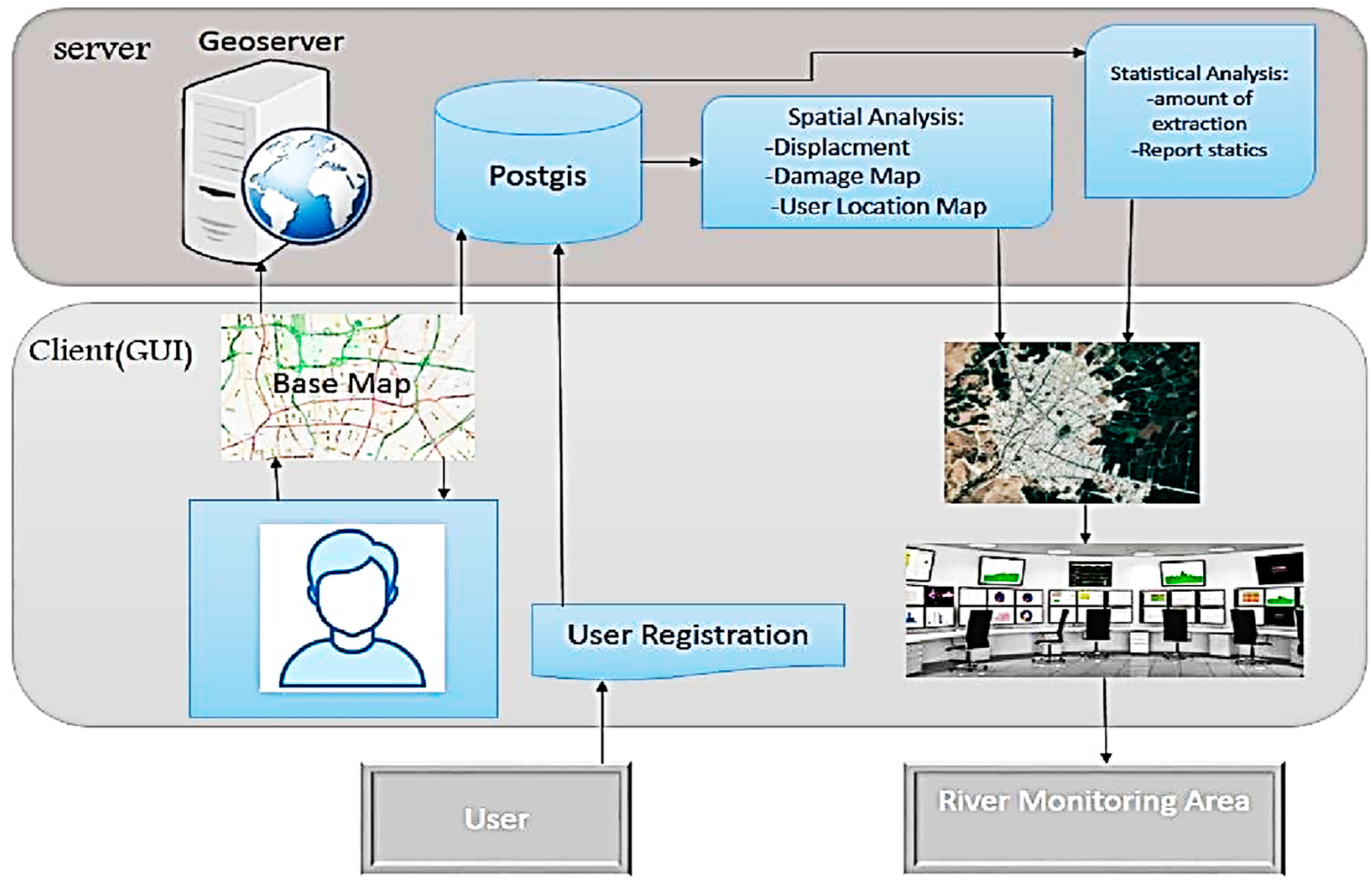
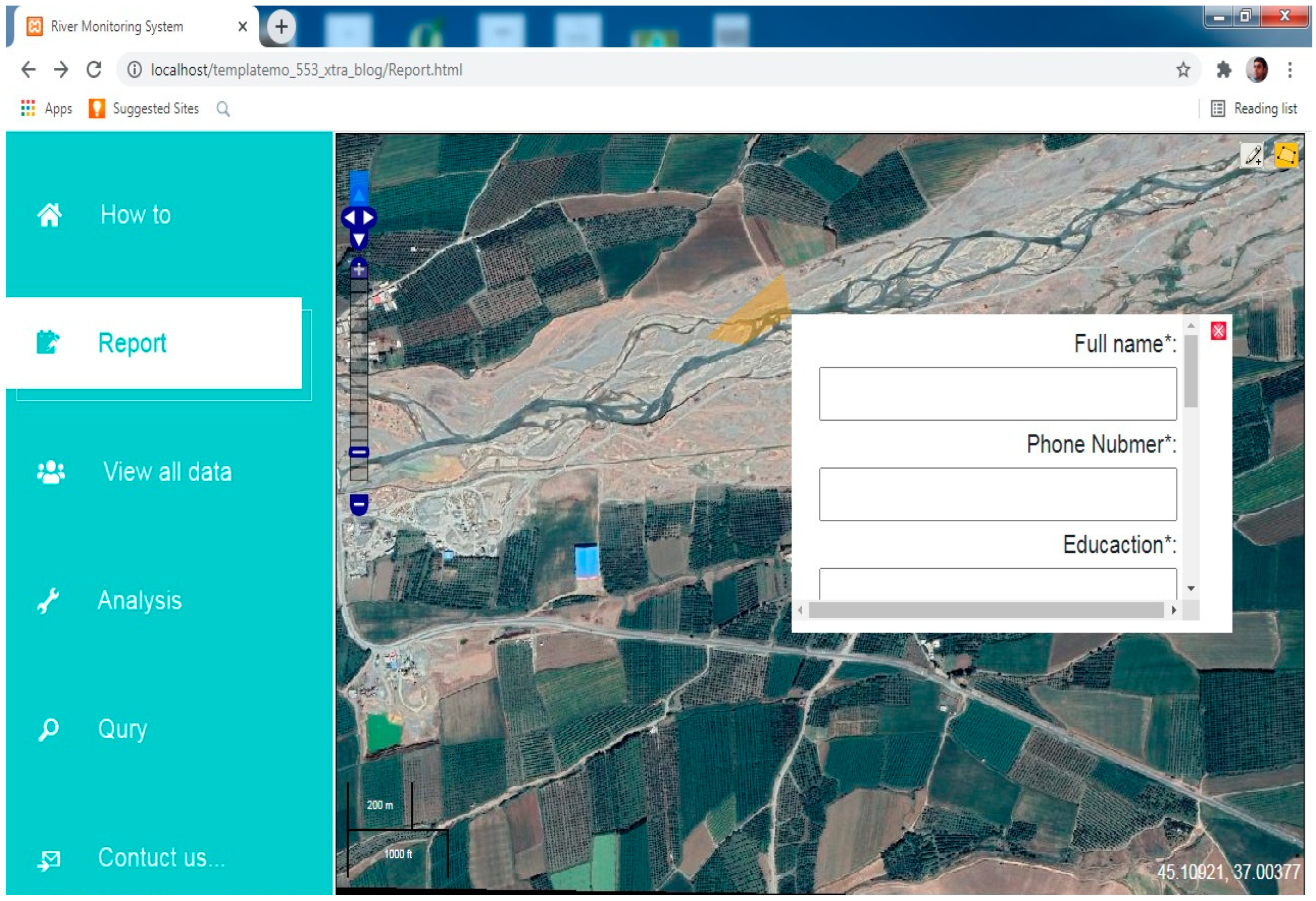


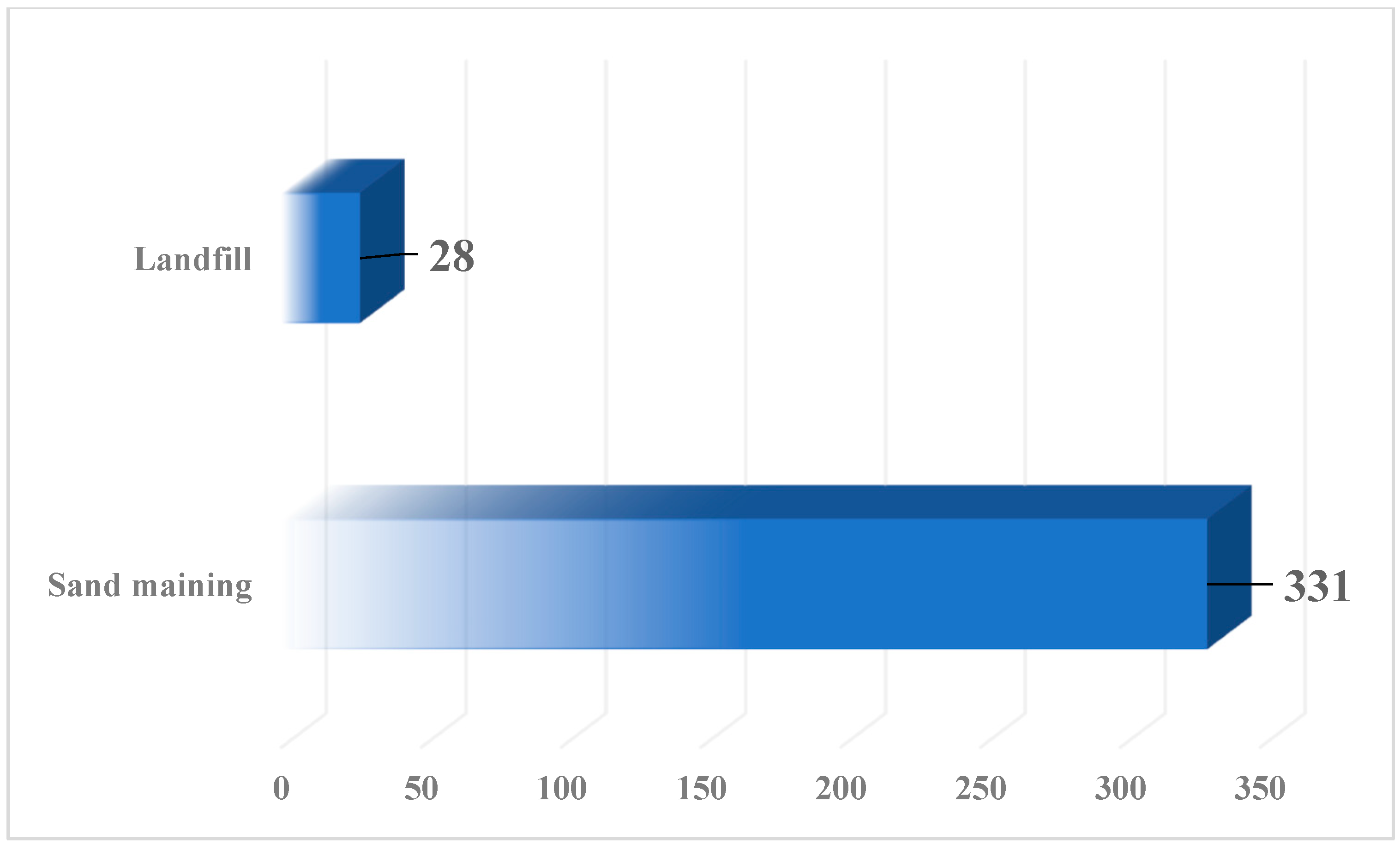
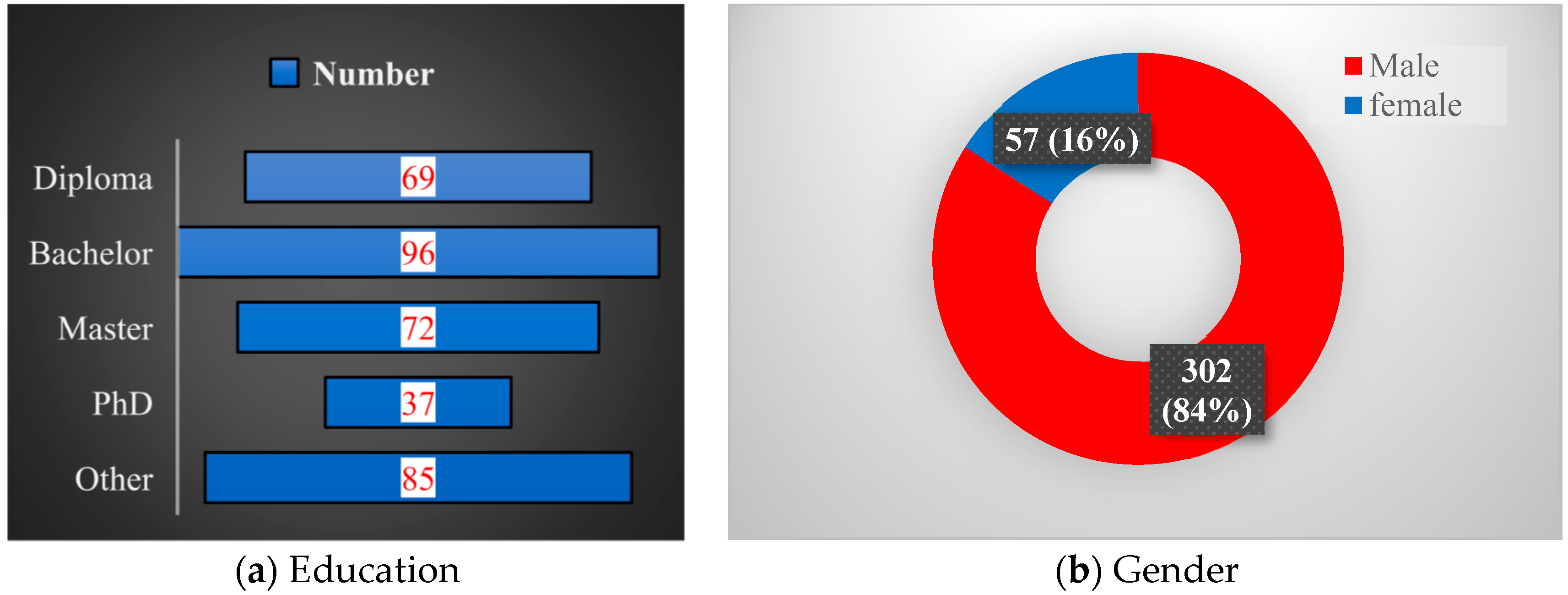
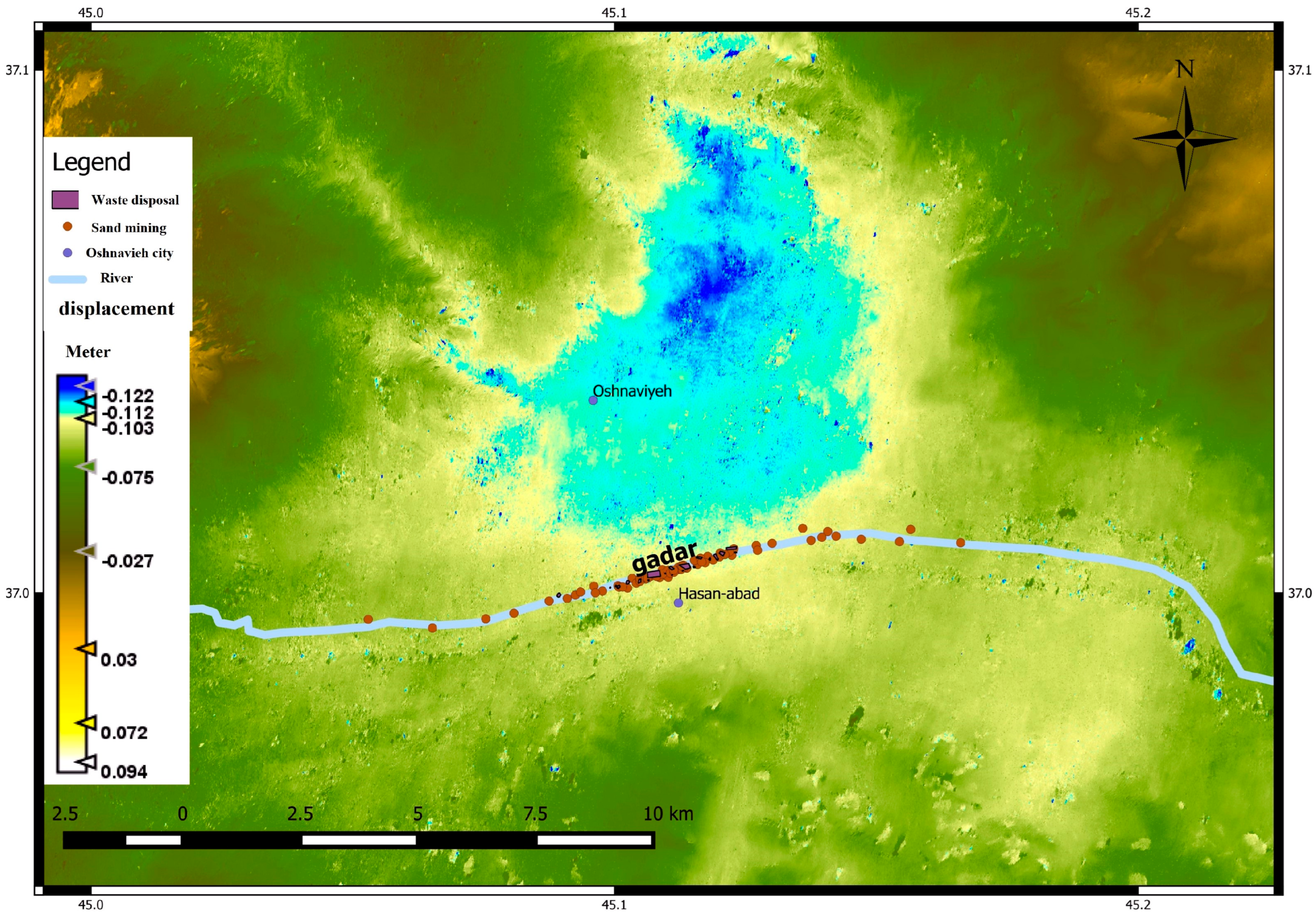

| Type of Images | Data | Channel | Polarization | Angle of Incidence | Spatial Resolution |
|---|---|---|---|---|---|
| Master | 15 February 2021 | C | VV | 23.8 | 5 × 20 |
| Slave | 23 June 2023 | C | VV | 23.8 | 5 × 20 |
| All Reports | TP | FP | FN | Completeness | Correctness | Quality |
|---|---|---|---|---|---|---|
| 359 | 338 | 21 | 27 | 94.15% | 92.48% | 86.63% |
Disclaimer/Publisher’s Note: The statements, opinions and data contained in all publications are solely those of the individual author(s) and contributor(s) and not of MDPI and/or the editor(s). MDPI and/or the editor(s) disclaim responsibility for any injury to people or property resulting from any ideas, methods, instructions or products referred to in the content. |
© 2024 by the authors. Licensee MDPI, Basel, Switzerland. This article is an open access article distributed under the terms and conditions of the Creative Commons Attribution (CC BY) license (https://creativecommons.org/licenses/by/4.0/).
Share and Cite
Bayazidy, M.; Maleki, M.; Khosravi, A.; Shadjou, A.M.; Wang, J.; Rustum, R.; Morovati, R. Assessing Riverbank Change Caused by Sand Mining and Waste Disposal Using Web-Based Volunteered Geographic Information. Water 2024, 16, 734. https://doi.org/10.3390/w16050734
Bayazidy M, Maleki M, Khosravi A, Shadjou AM, Wang J, Rustum R, Morovati R. Assessing Riverbank Change Caused by Sand Mining and Waste Disposal Using Web-Based Volunteered Geographic Information. Water. 2024; 16(5):734. https://doi.org/10.3390/w16050734
Chicago/Turabian StyleBayazidy, Mansour, Mohammad Maleki, Aras Khosravi, Amir Mohammad Shadjou, Junye Wang, Rabee Rustum, and Reza Morovati. 2024. "Assessing Riverbank Change Caused by Sand Mining and Waste Disposal Using Web-Based Volunteered Geographic Information" Water 16, no. 5: 734. https://doi.org/10.3390/w16050734
APA StyleBayazidy, M., Maleki, M., Khosravi, A., Shadjou, A. M., Wang, J., Rustum, R., & Morovati, R. (2024). Assessing Riverbank Change Caused by Sand Mining and Waste Disposal Using Web-Based Volunteered Geographic Information. Water, 16(5), 734. https://doi.org/10.3390/w16050734









